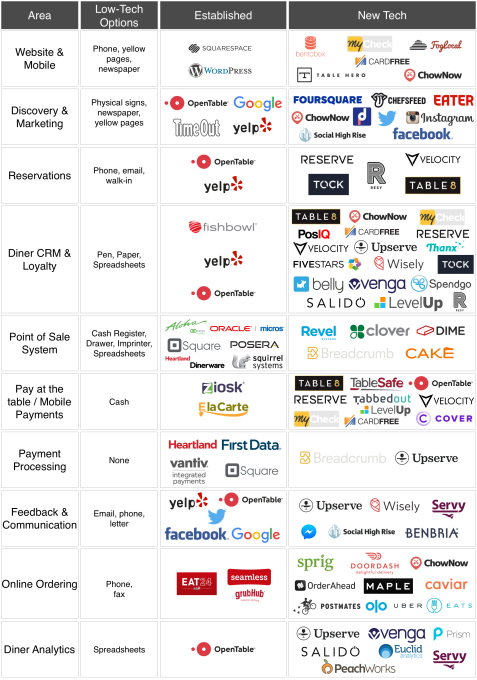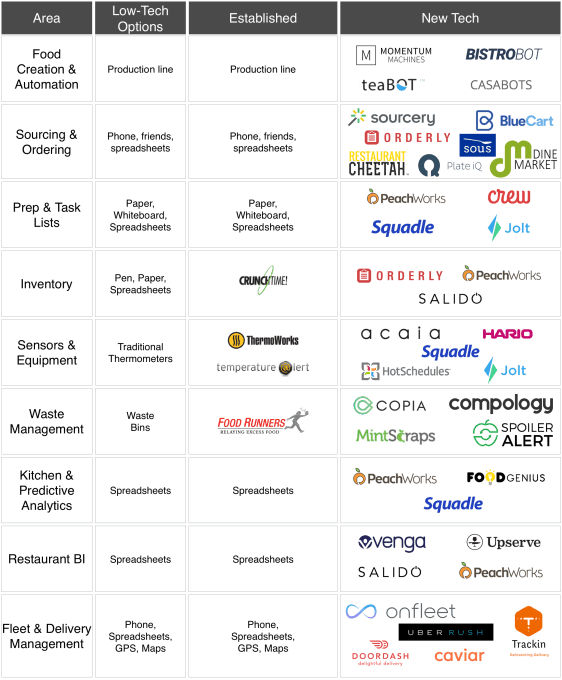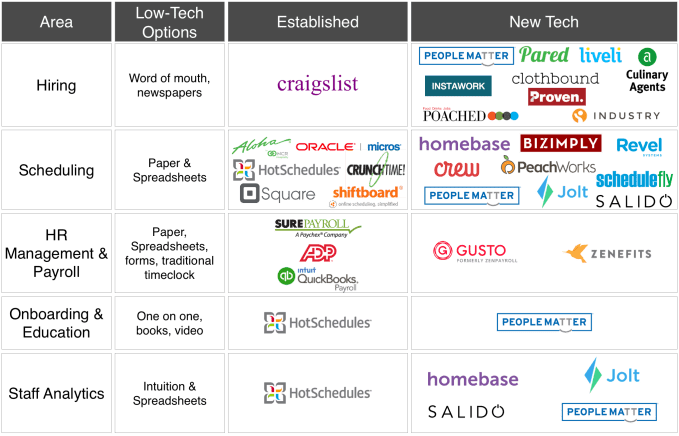Chris Caliz
So you’re a techie and a foodie. You’re having dinner and your phone buzzes to let you know you can pay for the meal you’re enjoying right from an app. It’s then you realize there’s something going on in restaurant tech.
If you want to know more, or get involved, this is your primer — because there is a lot of new action in the restaurant industry and we’re going to break some of it down.
Restaurateurs: Even though you have a wealth of resources dedicated to you, we hope this brief outline gives you a few ideas to consider if you’re looking to upgrade or switch your tech package.
What is the restaurant OS?
Just like the operating system (OS) for your computer, a restaurant needs a logical set of systems that allow it to do business efficiently. Well-known examples include OpenTable for reservations, NCR Aloha POS for check management and kitchen notification and Shiftboard to manage staff schedules. There are many operational requirements to run a restaurant; here we’ll highlight a few of the tech options that are vying to improve restaurant operations and consumer experiences.
Restaurant tech is not new: the point of sale machine introduced in the 1980s revolutionized how orders were placed and fired in the kitchen. Later, online reservation systems removed the need to call restaurants during business hours to request a table. Now, foodies in some cities are getting meals from their favorite table service restaurants delivered at home in less than an hour. Last year we saw more people were eating out than shopping for groceries.
Restaurants are working hard to upgrade their tech options in order to increase satisfaction, diner acquisition and retention, as well as optimize margins. Going out for a great meal is fun, but running a restaurant can be tough because of razor-thin margins and rising wages. There’s a lot of potential for dramatic growth for tech in the restaurant business.
Ingredients in the restaurant OS
To run smoothly, restaurants require several areas of operations — but there’s the catch, because restaurants are crazy places. Restaurant systems need to cope and adapt to a constantly changing environment. Of the many demands to running a restaurant, we’re focusing on restaurant-specific tech and products that price on recurring operating expenses; not real estate, design and capital expenditures for large equipment purchases or leases where generic tech or alternatives exist.
These breakdowns are by operational features, but there a few different feature alignments, producing repetition of some companies.
Diner experiences and front of house
Restaurant tech most heavily geared toward diners’ experience:

Kitchen and back of house
Products and tech focused on producing and delivering great food:

Staffing and staff management

Even with all the pretty logos and feature slices, there is still a lot of room for innovation and growth. In particular, the back of house has not changed much, and offers a lot of room for modernization or optimization.
In the discovery and reservation slices there are many players, but also plenty of overlap. With so many of them, the biggest stand out as very utilitarian and very expensive for restaurants. Meanwhile, the smaller ones are focusing on niche, but with a more competitive price package for businesses.
One more example of future innovation that’s needed is that we need personalized recommendations. There are many recommendation systems, but none offer great personalization. Finding a restaurant and choosing menu items can still be a roll of the dice. There’s a data deficit, and overcoming it leads to great personalization. In other words, we need something like the Netflix recommendation system for restaurants and food.
General observations
One size does not fit all. Just as not all restaurants are the same, not all technology or their product pricing structures are the same — and cannot be peanut buttered across all restaurants. If a restaurant experience is largely built on people and hospitality, tech is hard to implement and prove valuable. Fast, casual and quick service restaurants prove to be better environments for tech, in general. Finally, some restaurant tech products are geared for restaurant groups or chains.
Big POS terminals are the boss; tablets aren’t quite ready yet. Tablets are everywhere, but they’re not quite ready to replace every POS system, printer or terminal out there. Even the legacy POS providers like Micros offer tablet-optimized versions of their software. The biggest benefit of this is that it significantly reduces upfront costs and footprint.
Tablets also have a few problems that can impact some operations, like limited multitasking, a plethora of new devices to connect with, reliance on (potentially spotty) Wi-Fi, smaller screens and app competition with the host OS. These issues can actually lead to multiple tablets, with a single purpose each, taking up more room than promised.
The choice of POS impacts many other tech decisions. A restaurant’s choice of POS can impact and dictate a majority of other tech choices for it. The reasons are varied, from rich packages that include multiple features to limited integration options with other products.
A key example is the Square POS that offers no choice in other payment processors but has a marketplace of integrations, whereas Micros and Aloha support many payment processors but have few external product integrations.
All-in-one packages and lack of integrations build walled gardens. Wherever there is a package of several features, there are also natural conflicts with other products. For example, if a restaurant integrates an entire Aloha package, which comes with staff-scheduling capabilities, they may not want to consider something like Hot Schedules because it would reduce the ROI of the package deal and incur additional costs. Furthermore, that additional package may not even integrate with the POS, and creates an extra item the team needs to learn and remember to use.
It’s hard to compare labor costs with SaaS products. Restaurant owners or managers who don’t have a great staffing and payroll analytics package have a hard time quantifying human labor versus tech products. They want to reduce labor costs, but also aim to improve their margins overall.
So when considering a work-optimizing SaaS product, it can be tricky to figure out the value of the software to the time and effort. It is helpful that some providers have started talking about their costs relative to existing costs. A restaurant could consider itself similar to an early-stage tech startup, constantly managing a revenue and burn rate versus product/hire acquisition needs and likes.
Considerations for new products
If you’re working on a new product for the restaurant business, we want to know! But you should have a few things in mind to help you succeed.
First, please have a good grasp of the user journey of the decision-makers and the users. Any disruption in process/tools/tech can break a rhythm to service and be a cause for pushback from staff. Understanding the user journey and restaurant requirements should also help you understand that a normal consumer app MVP won’t cut it; you’ll need more thought and polish before you release.
Along with hospitality and care for interfacing with people, a product must have a thoroughly considered user journey so that business decision makers and users’ needs are completely covered. This should be obvious, but it is surprising to see how many products focus on one end without looking at the other. Restaurant tech is not at all like consumer app development.
Next, be mindful that not everyone in a restaurant will speak the same language or share the same level of tech savvy. On-boarding, training and support is paramount to success of your product, as well as the restaurant. You can’t get stickiness without constant pressure but keep it light and simple, because it will cut into overhead. Consider that staff turnover may impact your product usage and impact the restaurant’s desire to stick with something outside of the norm or established.
Finally, always keep in mind that restaurants are in the hospitality and service business. Anybody who approaches a restaurant without that mindset is likely to be rejected — this is all about relationships and how you support the industry.
As Danny Meyer says in Setting the Table, “Business, like life, is all about how you make people feel. It’s that simple, and it’s that hard.” When you reach out to a restaurant owner or manager to pitch them on your product, think carefully about when and how you reach out. Understand that restaurant owners and managers get a lot of solicitation for new things.
I’d like to thank Anna Tauzin at the National Restaurant Association, Seth Hammond at Stateside, Jeff Trenum at Blue Plate and Aimee Palacios for their insight and support.































Comment